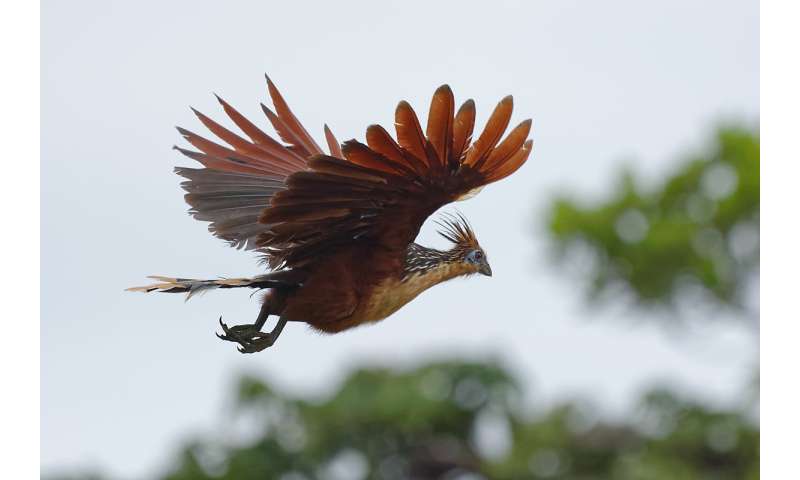#Avian tree of life better resolved
“#Avian tree of life better resolved”

Researchers led by Manfred Gahr of the Max Planck Institute for Ornithology in Seewiesen have investigated the relationship of bird families. For the first time, they have been able to clarify the relationship of all families of non-passerine birds and almost all families of passerine birds. The new family tree is based on gene sections that do not code for proteins, but contain sequences that are specific to the families and their genera.
The first trees of life in the animal kingdom were based on comparisons of the anatomy. Today, however, scientists analyze the phylogeny with molecular data. Using complex methods, genome segments of different species are studied and compared with each other.
The diversity of bird species increased rapidly for the first time after the extinction of dinosaurs 65 million years ago. Between 35 and 33 million years ago, during the Oligocene, the number of bird orders and families rose sharply once again. The new family tree also shows that the last increase in the Miocene, 23 to 15 million years ago, almost exclusively concerned the order of passerine birds (Passeriformes), to which the species, genus and family rich songbirds belong. However, hardly any new families developed in the other bird orders. Manfred Gahr, Director at the Max Planck Institute for Ornithology, considers the invention of song learning as the driving force behind the diversity of songbirds: “With many songbirds, the song of the male determines the willingness of the female to mate. New songs may have contributed to the emergence of new species.”
Non-coding sequences
The Max Planck team discovered that a certain molecular biological method can help to clearly differentiate bird groups. It is based on the analysis of all active genes in a cell, the so-called transcriptome. In addition to the sequences that are translated into proteins, the genes also contain various non-coding sequences. “These tend to be neglected. However, it has been shown that the non-coding sequences can resolve the avian family tree,” says Heiner Kuhl, first author of the study, who is now researching at the Leibniz Institute of Freshwater Ecology and Inland Fisheries.
“The non-coding sections contain sequences that are typical for an entire bird family. They can be used to determine exactly to which family a bird belongs. In addition, we also found sequences that were specific to the genera within the family,” stresses Carolina Frankl, co-author of the study.
The researchers were thus able to elucidate the relationship of all 106 bird families of the non-passerine birds and almost all (115 out of 130) families of the passerine birds. The latter is particularly complicated, since in recent years new genera have continuously been re-categorized to families, some of which contain only one or a few species and are therefore difficult to study.
Resolving the avian family tree
The Paleognaths (e.g. ostriches) separate quite early in the family tree. The Neognaths then divide into the Galloanserae (chickens and ducks) and the Neoaves (new birds). Within the new birds, the Mirandornithes (flamingos and grebes) have now been discovered to be the sister clade of all other orders. “The bizarre hoatzin, which could not be classified for a long time, had a last common ancestor with the Caprimulgiformes (nightjar, sailors, hummingbirds) about 64 million years ago,” says Carolina Frankl. At the top of the family tree are the Australaves, which include the passerines, parrots and hawks. This was already known.
The advantage of this transcriptome based method is that it allows the efficient analysis of relationships, using a large number of genes that occur in all bird species. “We don’t have to decipher and reassemble the entire genome in a time-consuming process. Also, a small drop of blood or a small piece of skin is sufficient for the analysis. Previous studies based on the sequences of complete genomes required supercomputers to calculate the tree of life, but with our methodology a powerful server is sufficient,” says Heiner Kuhl.
More information:
Kuhl et al., An unbiased molecular approach using 3′-UTRs resolves the avian family-level tree of life. Molecular Biology and Evolution. DOI: 10.1093/molbev/msaa191
Avian tree of life better resolved (2020, August 11)
retrieved 11 August 2020
from https://phys.org/news/2020-08-avian-tree-life.html
This document is subject to copyright. Apart from any fair dealing for the purpose of private study or research, no
part may be reproduced without the written permission. The content is provided for information purposes only.
If you want to read more Like this articles, you can visit our Science category.
if you want to watch Movies or Tv Shows go to Dizi.BuradaBiliyorum.Com for forums sites go to Forum.BuradaBiliyorum.Com



